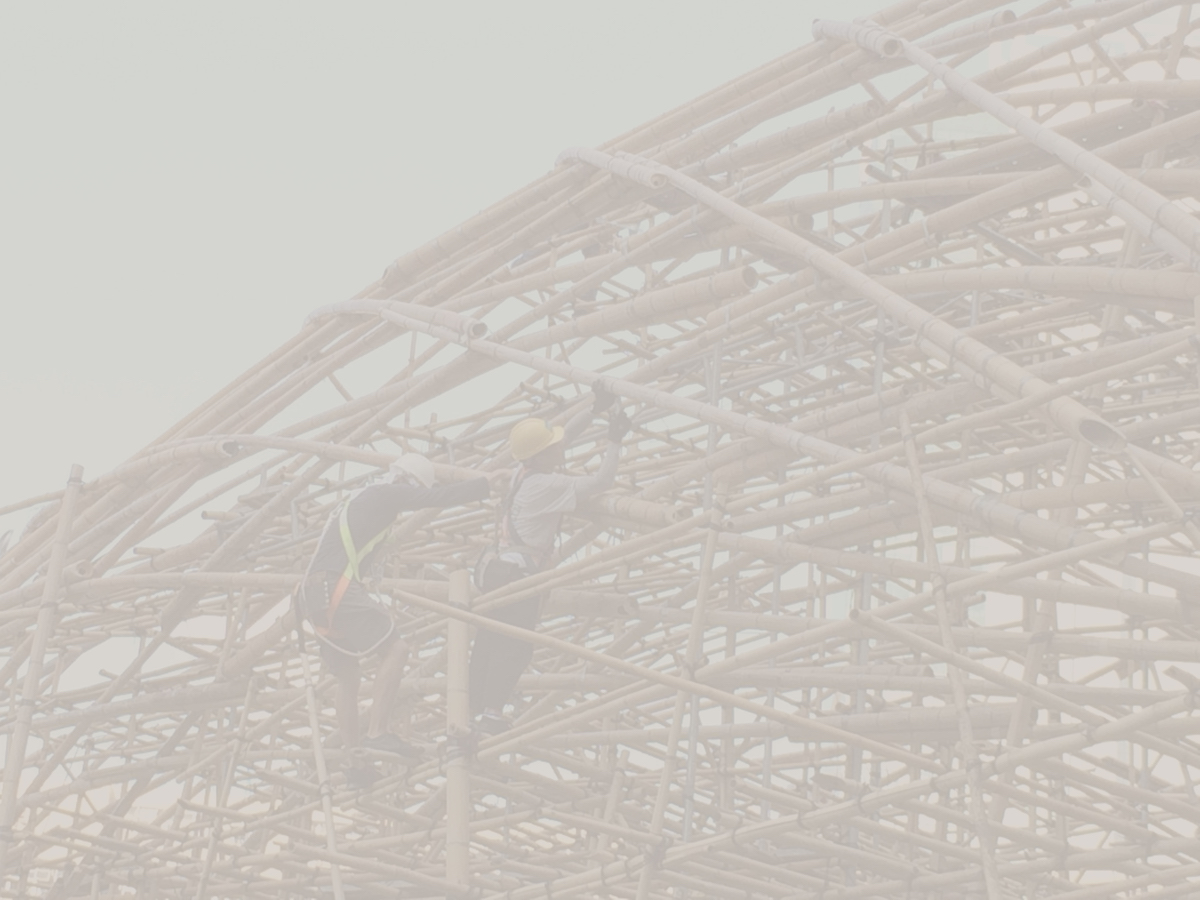ZCB Bamboo Pavilion
Kowloon Bay, Hong Kong, 2015

The ZCB Bamboo Pavilion is a public event space built for the Construction Industry Council’s Zero Carbon Building (ZCB) in the summer of 2015 in Kowloon Bay, Hong Kong. It is a four-storey-high long-span bending-active bamboo gridshell structure with a footprint of approximately 350m² and a seating capacity of 200 people.
It is built from 475 large bamboo poles that are bent onsite to shape the structure and that are hand-tied together with metal wire using techniques based on Cantonese bamboo scaffolding craftsmanship. The shape is a large diagrid shell structure that is folded down into three hollow columns. These columns rest on three circular concrete footings. A tailor-made white tensile fabric is stretched over the structure and is brightly lit from inside the three legs.
The project is the outcome of the concerted efforts of the Construction Industry Council (CIC), The Chinese University of Hong Kong (CUHK) and different contractors. It was designed by a research team led by Prof. Kristof Crolla at CUHK School of Architecture. The research investigates how computational design tools can be strategically inserted into existing construction methods to allow for a more engaging and innovative architectural outcome. The ZCB Bamboo Pavilion showcases this and illustrates how the endangered craftsmanship of bamboo scaffolding construction in Hong Kong can be expanded through the introduction of digital form-finding and real-time physics simulation tools.
The project’s design is based on an architecture student design internship held at the CUHK School of Architecture. The design was developed further by the research team in collaboration with structural engineers and bamboo consultants, using digital physics simulation engines, physical model making, and large-scale prototyping to derive its final form.
Bamboo is a widely available, environmentally friendly material that grows abundantly and at remarkably high speeds in the Asia-Pacific region, Africa and the Americas. It is an excellent renewable natural resource which captures CO₂ and converts it into oxygen. It is strong, light and easy to process and transport. In Hong Kong, bamboo mostly appears in temporary theatres, scaffolding, or structures for religious festivals. Globally, it is usually applied as a surrogate for wood or steel, rather than in ways that utilise the material’s unique bending properties and strength. In contrast, the ZCB Bamboo Pavilion presents an alternative architectural application that maximises these latent material properties.
The pavilion is geometrically complex. Bamboo has widely varying geometric, dimensional, and performative properties, and the scaffolding industry does not use conventional architectural drawings for its intuitive constructions. Building the project, therefore, challenged the boundaries of the architect’s design control. In response, new methods were developed that merged precise digital design systems with inconsistent natural resources in order to deal with these unpredictabilities.
The ZCB Bamboo Pavilion promotes innovative and ecological architectural design to the broader public and design community. It will be used to host exhibitions, performances and events that advocate low carbon living, construction, and development. By promoting sustainable, light-weight building methods for large span architecture, the project seeks ways for traditional Cantonese craftsmanship to evolve for the 21st century.
CUHK DESIGN RESEARCH TEAM:
Institute | The Chinese University of Hong Kong School of Architecture
Principal Investigator | Dr. Kristof CROLLA
Co-Investigator (Co-I) | Mr. Adam FINGRUT
Research Assistants (RA) | Mr. IP Tsz Man Vincent, Mr. LAU Kin Keung Jason
Structural Engineering | Dr. Goman HO & Dr. Alfred FONG
Bamboo Consultant | Mr. Vinc MATH
Authorised Person (AP) | Mr. Martin TAM
Registered Structural Engineer (RSE) | Mr. George CHUNG
Photography & Videography | Mr. NG Ka Hang Kevin
Photography | Grandy LUI & Michael LAW
Drone Photography | Mr. Ramon VAN DER HEIJDEN
CONSTRUCTION TEAM:
Main Contractor | W.M. Construction Ltd.
Bamboo Construction | Sun Hip Scaffolding Eng. Co., Ltd.
Fabric Contractor | Ladden Engineering Ltd.
Lighting | CONA Technology Co. Ltd. & Brandston Partnership Inc.
NOTE:
The CUHK project research was partially supported by a grant from the Research Grants Council of the Hong Kong Special Administrative Region China (Project No. CUHK24400114)





